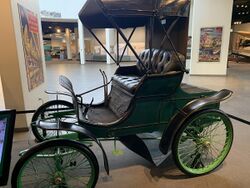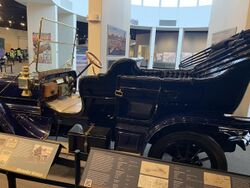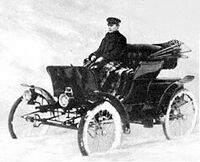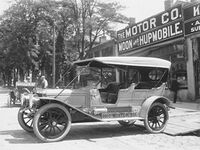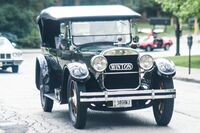Company:Winton Motor Carriage Company
 | |
| Type | Automobile Manufacturing |
|---|---|
| Industry | Automotive industry |
| Genre | Touring cars, limousines |
| Founded | 1897 |
| Founder | Alexander Winton |
| Defunct | 1962 |
| Headquarters | Cleveland, Ohio , |
Area served | United States |
| Products | Vehicles Automotive parts |
The Winton Motor Carriage Company was a pioneer United States automobile manufacturer based in Cleveland, Ohio. Winton was one of the first United States companies to sell a motor car. In 1912, Winton became one of the first American manufacturers of diesel engines.
History
1896–1903
In 1896, Scottish immigrant Alexander Winton, owner of the Winton Bicycle Company, turned from bicycle production to an experimental single-cylinder automobile before starting his car company.[1][lower-alpha 1]
The company was incorporated on March 15, 1897. Its first automobiles were built by hand. Each vehicle had painted sides, padded seats, a leather roof, and gas lamps. B.F. Goodrich made the tires.[3]
By this time, Winton had already produced two fully operational prototype automobiles. In May of that year, the 10 hp (7.5 kW) model achieved the astonishing speed of 33.64 mph (54.14 km/h) on a test around a Cleveland horse track. However, the new invention was still subject to much skepticism , so to prove his automobile's durability and usefulness, Alexander Winton had his car undergo an 800 mi (1,300 km) endurance run from Cleveland to New York City .[3]
On March 24, 1898, Robert Allison of Port Carbon, Pennsylvania, became the first person to buy a Winton automobile after seeing the first automobile advertisement in Scientific American.[3] Later that year the Winton Motor Carriage Company sold 21 more vehicles,[1] including one to James Ward Packard, who later founded the Packard automobile company after Winton challenged a very dissatisfied Packard to do better.[4]:58 This is the same mistake that Enzo Ferrari would make with Ferruccio Lamborghini.
Winton sold his first manufactured semi-truck in 1899. More than one hundred Winton vehicles were sold that year,[1]:23 making the company the largest manufacturer of gasoline-powered automobiles in the United States. This success led to the opening of the first automobile dealership by Mr. H. W. Koler[5] in Reading, Pennsylvania. To deliver the vehicles, in 1899, Winton built the first automobile hauler in America.[3] One of these 1899 Wintons was purchased by Larz Anderson and his new wife, Isabel Weld Perkins.[lower-alpha 2]
Publicity generated sales. In 1901, the news that both Reginald Vanderbilt and Alfred Vanderbilt had purchased Winton automobiles boosted the company's image substantially. Models at the time were a two-passenger Runabout with a one-cylinder engine (8 hp) and a four-passenger Touring and Mail Delivery Van, also with a one-cylinder engine (9 hp).[6] That year, Winton lost a race at Grosse Pointe to Henry Ford. Winton vowed a comeback and win. He produced the 1902 Winton Bullet, which set an unofficial land speed record of 70 mph (110 km/h) in Cleveland that year. The Bullet was defeated by another Ford by famed driver Barney Oldfield, but two more Bullet race cars were built.
In 1903, Dr. Horatio Nelson Jackson made the first successful automobile drive across the United States.[4]:156 On a $50 bet (equal to $1,423 today), he purchased a slightly used two-cylinder, 20 hp (15 kW) Winton touring car and hired a mechanic to accompany him. Starting in San Francisco, California , ending in Manhattan, New York City, New York. The trip lasted 63 days, 12 hours, and 30 minutes, including breakdowns and delays while waiting for parts to arrive (especially in Cleveland.[7]) The two men often drove miles out of the way to find a passable road, repeatedly hoisted the Winton up and over rocky terrain and mud holes with a block and tackle, or were pulled out of soft sand by horse teams.[8] In 1903, there were only 150 miles of paved road in the entire country, all inside city limits. There were no road signs or maps. They once paid the exorbitant price of $5 for five gallons of gasoline. Jackson and his partner followed rivers and streams, transcontinental railroad tracks, sheep trails, and dirt back roads.[9][lower-alpha 3]
1903 Horatio Nelson Jackson in his two-seat Winton tourer, "The Vermont", drives across America
1904–1924
The 1904 Winton was a five-passenger tonneau-equipped tourer which sold for US$2,500. By contrast, the Enger 40 was US$2,000,[4]:104 the FAL US$1,750,[4]:104 an Oakland 40 US$1,600,[4]:84 the Cole 30[4]:104 and Colt Runabout US$1,500,[4]:63 while the (1913) Lozier Light Six Metropolitan started at US$3,250,[4]:111 American's lowest-priced model was US$4,250,[4]:91 and Lozier's Big Six were US$5,000 and up.[4]:111
- Models (1904)
Type Engine HP Wheelbase Transmission Touring-5p. Two-cylinder 20 94.5" 2-speed sliding-gear[10] Touring-5p. Four-cylinder 24 104" 2-speed sliding-gear
Winton's flat-mounted water-cooled straight-twin engine, situated amidships of the car, produced 20 hp (15 kW). The channel and angle steel-framed car weighed 2,300 lb (1,000 kg).
- Models (1914)[6]
Model Engine HP Wheelbase Model 20 Six-cylinder 48.6 130"
Winton continued to successfully market automobiles to upscale consumers through the 1910s, but sales began to fall in the early 1920s. This was due to the very conservative nature of the company, both in terms of technical development and styling. Only one sporting model was offered — the Sport Touring, with the majority of Wintons featuring tourer, sedan, limousine and town car styling.[11] The Winton Motor Carriage Company ceased automobile production on February 11, 1924.
- Models (1922)[6]
Model Engine HP Wheelbase Model 40 Six-cylinder 70/72 132"
Winton Engine Company
In 1912, Winton started producing diesel engines for stationary and marine use, and gasoline engines for heavy vehicles, independent of Winton's automobile production. The subsidiary Winton Engine Company remained successful while Winton's automotive sales went into decline, and would outlive the Winton Motor Carriage Company. Winton became the main supplier of engines for internal combustion-electric powered railcars in the 1920s.
Sale to General Motors
On June 20, 1930, Winton Engine Company was sold to General Motors and on June 30 was reorganized as the Winton Engine Corporation subsidiary of General Motors. It produced the first practical two-stroke diesel engines in the 400-to-1,200 hp (300 to 900 kW) range, which powered the early diesel locomotives of Electro-Motive Corporation (another General Motors subsidiary), as well as United States Navy submarines. In 1934, a Winton eight-cylinder, 600 hp (450 kW) 8-201-A diesel engine powered the revolutionary streamlined passenger train the Burlington Zephyr, the first American diesel-powered mainline train. The Winton Engine Corporation provided 201 Series engines for rail use until late 1938, when it was reorganized as the General Motors Cleveland Diesel Engine Division, which produced the GM 567 series locomotive engines, and other large diesels for marine and stationary use. In 1941, locomotive engine production became part of General Motors Electro-Motive Division (EMD). In 1962, Cleveland Diesel was absorbed by Electro-Motive Division, which remains in business today as a subsidiary of Progress Rail.[13][14]
Marine engines
Winton and Cleveland engines were used widely by the U.S. Navy in World War II, powering submarines, destroyer escorts, and numerous auxiliaries. The Winton engines were systematically replaced with the more reliable Cleveland Diesel engines during refittings during the war.[13][15][16][17][18][19]
In popular culture
A purpose-built "Winton Flyer" features prominently in William Faulkner's Pulitzer Prize–winning 1962 novel The Reivers. In fact, the 1969 film version of the novel starring Steve McQueen was known as The Yellow Winton Flyer in the UK.[20]
See also
- List of defunct United States automobile manufacturers
Notes
- ↑ Winton owned a large lakeshore estate in Lakewood, Ohio.[2] In the mid-1960s, the home was demolished, and an upscale high-rise condominium was constructed aptly named Winton Place.
- ↑ The vehicle is displayed at Larz Anderson Auto Museum in Brookline, Massachusetts.[3]
- ↑ Jackson's Winton is part of the collections at the National Museum of American History.
References
- ↑ 1.0 1.1 1.2 100 Years of the American Auto (Millennium ed.). Publications International, Ltd.. 1999.
- ↑ History of Winton Automobile Company at historic-structures.com
- ↑ 3.0 3.1 3.2 3.3 3.4 Hedgbeth, Llewellyn. "Winton: The King of Cars". secondchancegarage.com. http://www.secondchancegarage.com/classic-car/winton-the-king-of-cars-1.cfm.
- ↑ 4.0 4.1 4.2 4.3 4.4 4.5 4.6 4.7 4.8 4.9 Clymer, Floyd (1950). Treasury of Early American Automobiles, 1877–1925. New York: Bonanza Books.
- ↑ "The Family of Winton". http://www2.thesetonfamily.com:8080/directory/family_of_winton.htm.
- ↑ 6.0 6.1 6.2 Kimes, Beverly (1996). Standard catalog of American Cars 1805–1942. Krause Publications. p. 1556. ISBN 0-87341-428-4.
- ↑ Stein, Ralph (1971). The American Automobile. Random House. https://archive.org/details/americanautomobi00stei.
- ↑ "Winton touring car". Smithsonian Institution. 2 November 2016. http://americanhistory.si.edu/onthemove/collection/object_24.html.
- ↑ Burns, Ken (Director) (2003). Horatio's Drive; America's First Road Trip (Documentary film).
- ↑ "Miscellaneous Brochures and Data / Autos of 1904 Booklet". http://www.oldcarbrochures.com/static/Misc%20Brochures/Autos%20of%201904%20Booklet/Autos%20of%201904-10.html.
- ↑ Spajic, Igor. "Vintage Cars of 'The Great Gatsby' — Winton Six". vintagecarheritage.com. http://www.vintagecarheritage.com/vintage-cars-of-the-great-gatsby-winton-six/.
- ↑ Tom (2013-09-14). "1911 Advertisement for Winton Six at Mt. Royal and North Ave." (in en-US). https://ghostsofbaltimore.org/2013/09/14/1911-advertisement-winton-six-mt-royal-north-ave/.
- ↑ 13.0 13.1 "Cleveland Diesel Model 278A". Old Marine Engines. Tugboat Enthusiasts Society of the Americas. http://www.tugboatenthusiastsociety.org/pages/tugmach-diesel-historic-CDED-278A.htm.
- ↑ Pinkpank, Jerry A. (1973). The Second Diesel Spotter's Guide. Kalmbach Books. pp. 25–26.
- ↑ Silverstone, Paul H (1966). U.S. Warships of World War II. Doubleday and Company. pp. 164–167.
- ↑ McCurtie, Francis E. (1998). Jane's Fighting Ships of World War II. Crescent Books (Random House). pp. 288, 290–291. ISBN 0517-67963-9. https://archive.org/details/janesfightingshi00fran/page/288.
- ↑ "The Reivers". https://www.loc.gov/item/jots.200018769/.
External links
- Winton sales literature for models A, B, C and Limousine—The description at the site explains the format: "Designed to be folded in various combinations so that the text can be displayed under the corresponding image. In this digital edition each photo is displayed with the corresponding text folded to appear under the photo. The two sides of the complete, unfolded strip are also included as an application/pdf file as the final image."
- A collection of Winton magazine advertisements (1902–1917)
- A collection of sales literature for the Winton Six 1911, 1912, 1913, and 33
- Secondhandgarage.com: History of the Winton Motor Carriage Company
- Historic American Engineering Record (HAER) No. OH-11, "Cleveland Automobile Industry, Cleveland, Cuyahoga County, OH", 34 data pages
- HAER No. OH-11-A, "Winton Motor Carriage Company, Berea Road & Madison Avenue, Cleveland, Cuyahoga County, OH", 11 photos, 15 data pages, 2 photo caption pages
 |
